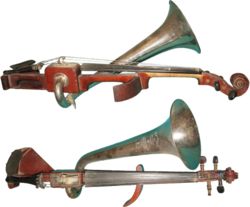Stroh violin
 |
|
| Classification | |
|---|---|
| Related instruments | |
Stroh is a maker using Stroviols, as a trade name for their phono instruments, which include violin, viola, cello, bass, ukulele, slide guitar, and mandolin. There are also numerous Stroviols one string phonofiddles made. These instruments are named after their designer, John Matthias Augustus Stroh, an electrical engineer in London, who patented it. On 4 May 1899, Stroh applied for a UK patent, GB9418 titled Improvements in Violins and other Stringed Instruments which was accepted on 24 March 1900. This described the use of a flat metal (other materials are also mentioned) diaphragm in the voice-box (reproducer) of a violin to mechanically amplify the sound. Then on 16 February 1901 he applied for a second UK patent, GB3393 titled Improvements in the Diaphragms of Phonographs, Musical Instruments, and anologous Sound-producing, Recording and Transmitting Contrivances. Which was accepted on 14 December 1901. This effectively extended the first concept to now use a conical resonator with corrugations at its edge, allowing a more 'rigid' diaphragm. His failure to register his inventions in the USA allowed John Dopyera and Geo Beauchamp to subsequently obtain US patents for the tricone and single cone designs used in National brand instruments. The Stroh violin is also closely related to other horned violins using a mica sheet-resonating diaphragm, known as phonofiddles. Willy Tiebel in Markneukirken Germany made Stroh violin copies in the 1920s.
There were other makers such as Howson who made brass horned phono instruments including various one stringed phono fiddles and 4 string phono ukuleles. The violinophone was made in Prague early 20th century. This instrument has a diaphragm mounted vertically in a violin body under the bridge. The sound is carried through a tube to the horn which protrudes from the violin to a long horn which wraps around the shoulder. —a violin that amplifies its sound through a metal resonator and metal horns rather than a wooden sound box as on a standard violin. The Romanian phono folk instruments are made from trumpet bells (Romanian: Vioara cu goarnă)
In the present day, many types of horn-violin exist, especially in the Balkans.
Stroh violins are much louder than a standard wooden violin, and its directional projection of sound made it particularly useful in the early days of phonographic recording. Since regular violins recorded weakly with the old acoustic-mechanical recording method, Stroh violins were common in recording studios, but became rarer after record companies switched to the new electric microphone recording technology in the second half of the 1920s. The Stroh produces significantly more volume, and it has a surprisingly good tone, nearly comparable to that of a standard violin. On early records the violin can almost be recognized by its thin whining tone. The Stroh violin successfully replaced that limitation with a full, nearly accurate violin sound.
...
Wikipedia
